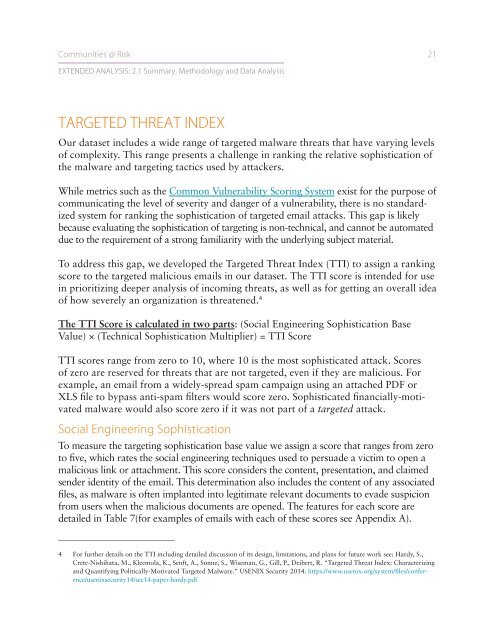2-Extended Analysis-Full
2-Extended Analysis-Full
2-Extended Analysis-Full
You also want an ePaper? Increase the reach of your titles
YUMPU automatically turns print PDFs into web optimized ePapers that Google loves.
Communities @ Risk 21EXTENDED ANALYSIS: 2.1 Summary, Methodology and Data <strong>Analysis</strong>TARGETED THREAT INDEXOur dataset includes a wide range of targeted malware threats that have varying levelsof complexity. This range presents a challenge in ranking the relative sophistication ofthe malware and targeting tactics used by attackers.While metrics such as the Common Vulnerability Scoring System exist for the purpose ofcommunicating the level of severity and danger of a vulnerability, there is no standardizedsystem for ranking the sophistication of targeted email attacks. This gap is likelybecause evaluating the sophistication of targeting is non-technical, and cannot be automateddue to the requirement of a strong familiarity with the underlying subject material.To address this gap, we developed the Targeted Threat Index (TTI) to assign a rankingscore to the targeted malicious emails in our dataset. The TTI score is intended for usein prioritizing deeper analysis of incoming threats, as well as for getting an overall ideaof how severely an organization is threatened. 4The TTI Score is calculated in two parts: (Social Engineering Sophistication BaseValue) × (Technical Sophistication Multiplier) = TTI ScoreTTI scores range from zero to 10, where 10 is the most sophisticated attack. Scoresof zero are reserved for threats that are not targeted, even if they are malicious. Forexample, an email from a widely-spread spam campaign using an attached PDF orXLS file to bypass anti-spam filters would score zero. Sophisticated financially-motivatedmalware would also score zero if it was not part of a targeted attack.Social Engineering SophisticationTo measure the targeting sophistication base value we assign a score that ranges from zeroto five, which rates the social engineering techniques used to persuade a victim to open amalicious link or attachment. This score considers the content, presentation, and claimedsender identity of the email. This determination also includes the content of any associatedfiles, as malware is often implanted into legitimate relevant documents to evade suspicionfrom users when the malicious documents are opened. The features for each score aredetailed in Table 7(for examples of emails with each of these scores see Appendix A).4 For further details on the TTI including detailed discussion of its design, limitations, and plans for future work see: Hardy, S.,Crete-Nishihata, M., Kleemola, K., Senft, A., Sonne, S., Wiseman, G., Gill, P., Deibert, R. “Targeted Threat Index: Characterizingand Quantifying Politically-Motivated Targeted Malware.” USENIX Security 2014. https://www.usenix.org/system/files/conference/usenixsecurity14/sec14-paper-hardy.pdf


